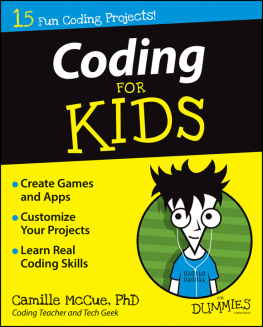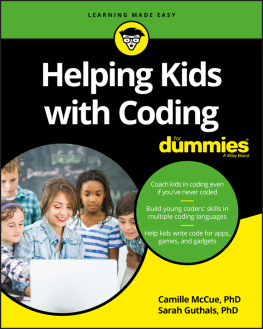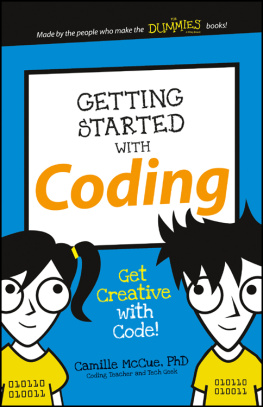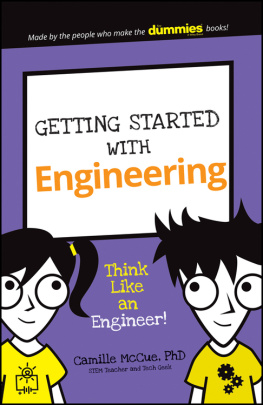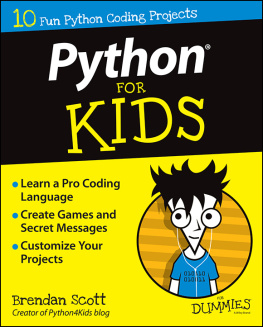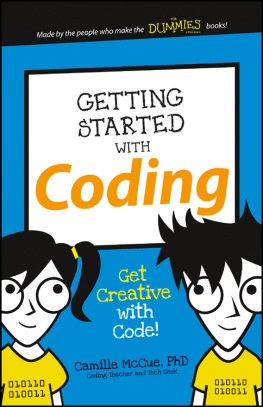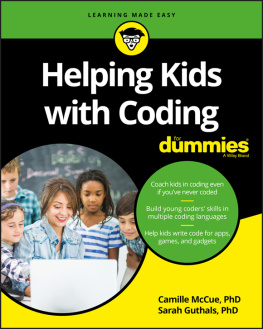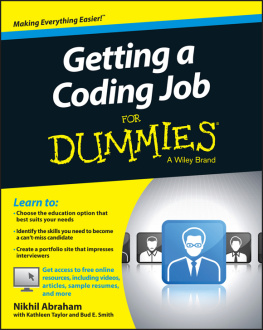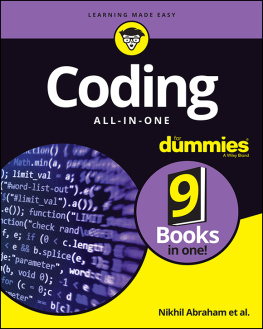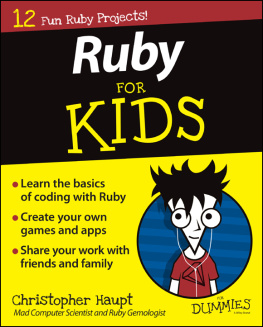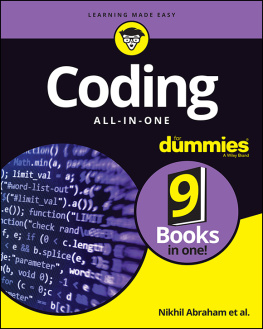Camille McCue - Coding For Kids For Dummies
Here you can read online Camille McCue - Coding For Kids For Dummies full text of the book (entire story) in english for free. Download pdf and epub, get meaning, cover and reviews about this ebook. year: 2014, publisher: For Dummies, genre: Home and family. Description of the work, (preface) as well as reviews are available. Best literature library LitArk.com created for fans of good reading and offers a wide selection of genres:
Romance novel
Science fiction
Adventure
Detective
Science
History
Home and family
Prose
Art
Politics
Computer
Non-fiction
Religion
Business
Children
Humor
Choose a favorite category and find really read worthwhile books. Enjoy immersion in the world of imagination, feel the emotions of the characters or learn something new for yourself, make an fascinating discovery.
- Book:Coding For Kids For Dummies
- Author:
- Publisher:For Dummies
- Genre:
- Year:2014
- Rating:5 / 5
- Favourites:Add to favourites
- Your mark:
- 100
- 1
- 2
- 3
- 4
- 5
Coding For Kids For Dummies: summary, description and annotation
We offer to read an annotation, description, summary or preface (depends on what the author of the book "Coding For Kids For Dummies" wrote himself). If you haven't found the necessary information about the book — write in the comments, we will try to find it.
Coding For Kids For Dummies — read online for free the complete book (whole text) full work
Below is the text of the book, divided by pages. System saving the place of the last page read, allows you to conveniently read the book "Coding For Kids For Dummies" online for free, without having to search again every time where you left off. Put a bookmark, and you can go to the page where you finished reading at any time.
Font size:
Interval:
Bookmark:
With childhood activities that included tinkering with her Apple II+ computer and conducting science fair research, Camille McCue, Ph.D. developed an early love of STEM (science, technology, engineering, and mathematics). She earned her math degree at the University of Texas at Austin and worked in IBM PC marketing for two years prior to becoming a physics teacher to rural youth via BUD (big ugly dish) satellite. For the next 12 years, Camille produced and anchored live television programming for NASA and PBS, connecting kids with experts on topics as varied as orbiting astronauts and Antarctic penguin researchers.
Since 2005, she has taught video game programming, math enrichment, tech mashup, and future cities engineering at the Alexander Dawson School in Las Vegas, Nevada. Additionally, she teaches at the University of Nevada, Las Vegas (UNLV), as well as speaks frequently at professional conferences.
She has served on the editorial board of the Mathematics Teaching in the Middle School journal (published by the National Council of Teachers of Mathematics) and written lessons for the NCTM Illuminations website. In 2012, she was selected by the Gaming2Learn initiative to pilot-teach Survival Master, engineering gaming software developed through a multimillion-dollar National Science Foundation grant.
She earned her advanced degrees in curriculum and instruction with her doctoral research at UNLV focused on tween coding. Camille currently serves as Director of Dawson College Bound, a program mentoring citywide youth towards academic success in high school and university. Camille and her fantastic husband Michael are the proud parents of two incredible sons, Ian and Carson. Coding For Kids For Dummies is Camilles sixth technology book for Wiley.
To Carson.
Thanks to the indefatigable team at Wiley for their work in helping craft this first installment of the For Kids For Dummies series! Steve Hayes, although your professional title has changed and become increasingly more impressive over the years now Executive Editor you have always been a boots-on-the-ground kind of guy who magically turns ideas into products. Thank you so much for your guidance, collaboration, and friendship over many years of creating books. Senior Project Editor Kim Darosett: I am in your debt for your deep expertise in communicating technology, your flexibility in managing this bag of snakes, and your patience in listening to my opinions (also known as soapbox rants) about adapting the writing for a kid audience. I was elated when you caught errata because you were actually working through every step of every project! I am honored and humbled by your incredibly detailed work.
Id also like to thank marketing manager Raichelle Weller and copyeditor Linda Morris for their efforts in polishing and packaging this book just so. Many thanks also to the brilliant Susan Einhorn, president of Logo Computer Systems Inc. (LCSI), who served as technical editor for this project. Your exceptional knowledge of programming pedagogy kicked it up a notch (as they say in Futurama) and ensured that the projects are not only technically accurate, but also instructionally sound. Thank you also to Michael Quinn of LCSIs Board of Directors for providing day-in and day-out support for my use of MicroWorlds EX at the Alexander Dawson School over the past decade, and for supporting the marriage between the highly-organized For Dummies approach and the exploratory playground approach of all things Logo.
Many thanks to the Alexander Dawson Foundation Board of Trustees and our school leadership for affording me the opportunity to bring innovative approaches to curriculum and instruction to our school, including the creation of courses featuring coding, and to the many students whom I have had the privilege of teaching and learning from over the years. Additionally, Id like to acknowledge the tireless support of my colleagues and mentors at UNLV who helped shape my research activities addressing middle-school math and coding. Thank you also to Dawson students Sophie Gray and Stella Gray and to UNLV professor Dr. David James, who provided review and commentary of project concepts; to my Dawson fifth graders who critiqued the book cover design; and to my Dawson College Bound coordinator Cathi Muckle for her always-steadfast assistance.
Most of all, an enormous, heartfelt thank you to my husband Michael, my children, and my mother Beverly Dempsey-Moody who have championed my efforts to lean in professionally (as Sheryl Sandberg would say). I am especially grateful to my boys, Ian McCue and Carson McCue, for serving as in-house testers of MicroWorlds EX projects all these years (and to Carson for his Monster Mashup character designs in this book). Finally, thank you to the legendary Dr. Seymour Papert, the man who envisioned children using computers as tools for expressing creativity through his Logo programming environment. You changed the world and fostered a love of coding among millions. I hope this book celebrates and continues your work by encouraging a new generation of kids to embrace and appreciate the power of programming.
Publishers Acknowledgments
Executive Editor: Steven Hayes
Senior Project Editor: Kim Darosett
Copy Editor: Linda Morris
Technical Editors: Susan Einhorn and Michael Quinn
Editorial Assistant: Claire Johnson
Sr. Editorial Assistant: Cherie Case
Project Coordinator: Erin Zeltner
Cover Image: iStock.com / Portugal2004
Project 0
Until the last few decades, education focused on skills called the three Rs reading, writing, and arithmetic. (I know what youre thinking adults who believe all these words begin with the letter R need to return to kindergarten!) If you mastered the three Rs, you were considered an educated person. But now, technology has changed everything. In your personal life, in school, and in your parents jobs, technology is in constant use. And communicating with technology requires a new skill called coding, or computer programming.
In this chapter, I explain what coding is and describe the types of projects you can create. Then, I introduce you to MicroWorlds EX, which is the software that you will use to create the projects in this book, as well as connect you with additional resources for extending your learning.
Coding means writing instructions that a piece of technology usually a computer understands so that the technology will perform a task. A computer programming language provides the vocabulary (words) and syntax (rules and punctuation) for communicating with a computer.
The instructions that you write and that the computer reads are a program. A computer program comprises code and communicates instructions about what is supposed to show on a computer screen and when it is supposed to happen. As you learn a computer programming language, you will be able to read and understand programs already written. Most importantly, you will be able to code that is, design and write your own original programs.
Learning to understand and create code in a computer programming language allows you to communicate with technology. Just like there are tons of human languages, there are tons of computer programming languages. If youre wondering which programming language you should learn, the answer is any one of them! After you learn one programming language, there will be many similarities between that language and any other programming language you may need. Still, there are some programming languages that are much easier to start with and much more fun to learn if youre a kid. And you
Font size:
Interval:
Bookmark:
Similar books «Coding For Kids For Dummies»
Look at similar books to Coding For Kids For Dummies. We have selected literature similar in name and meaning in the hope of providing readers with more options to find new, interesting, not yet read works.
Discussion, reviews of the book Coding For Kids For Dummies and just readers' own opinions. Leave your comments, write what you think about the work, its meaning or the main characters. Specify what exactly you liked and what you didn't like, and why you think so.

